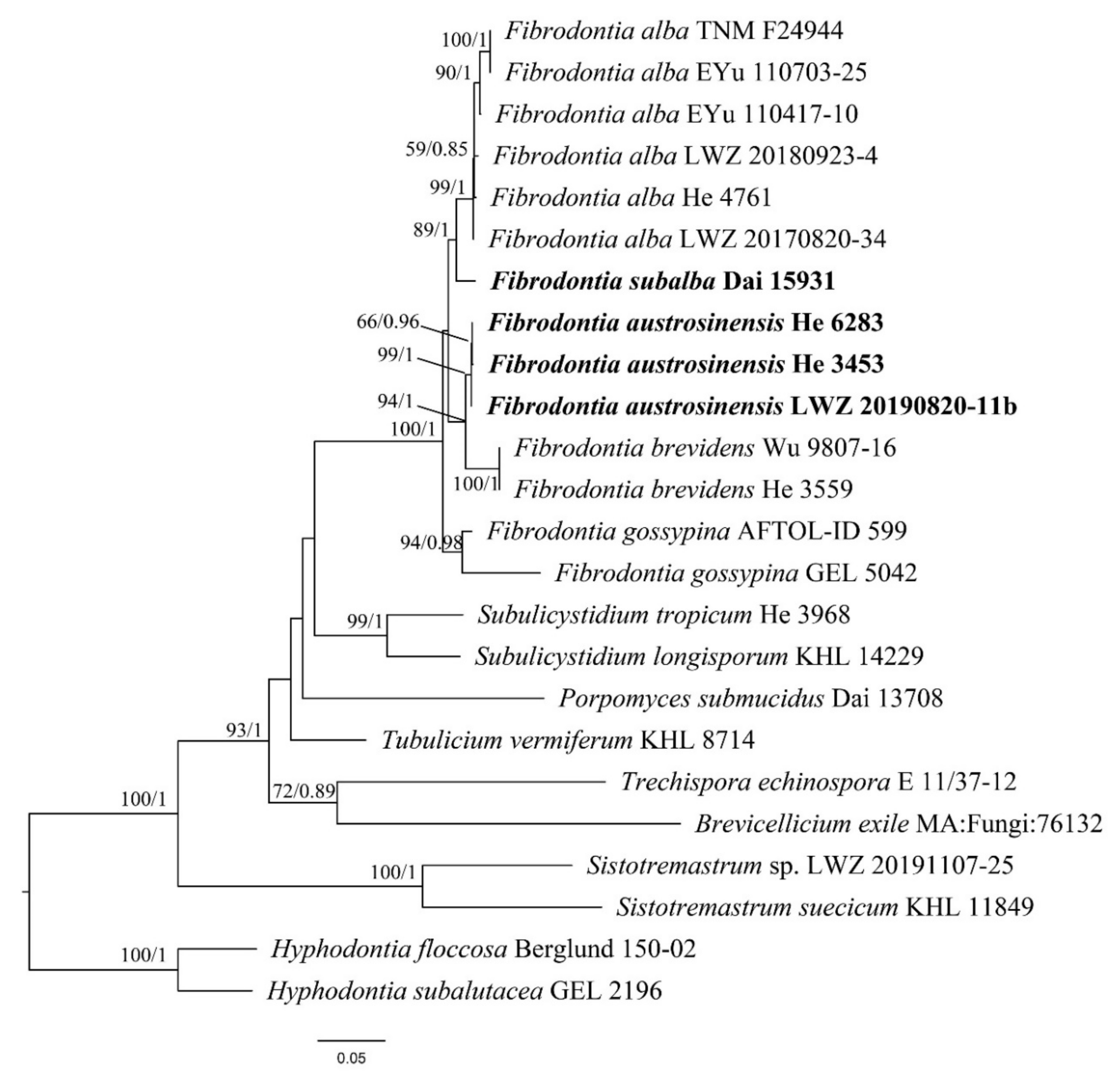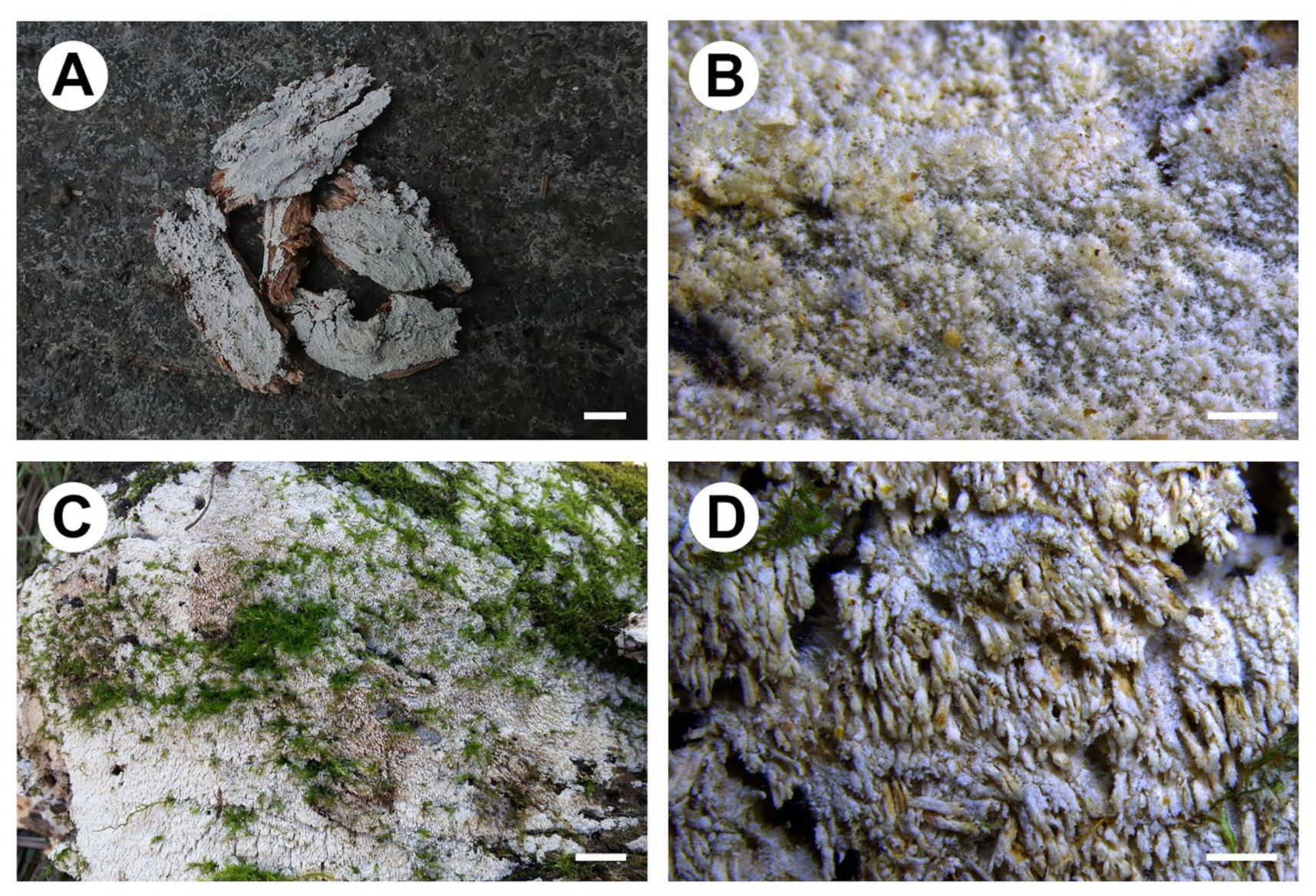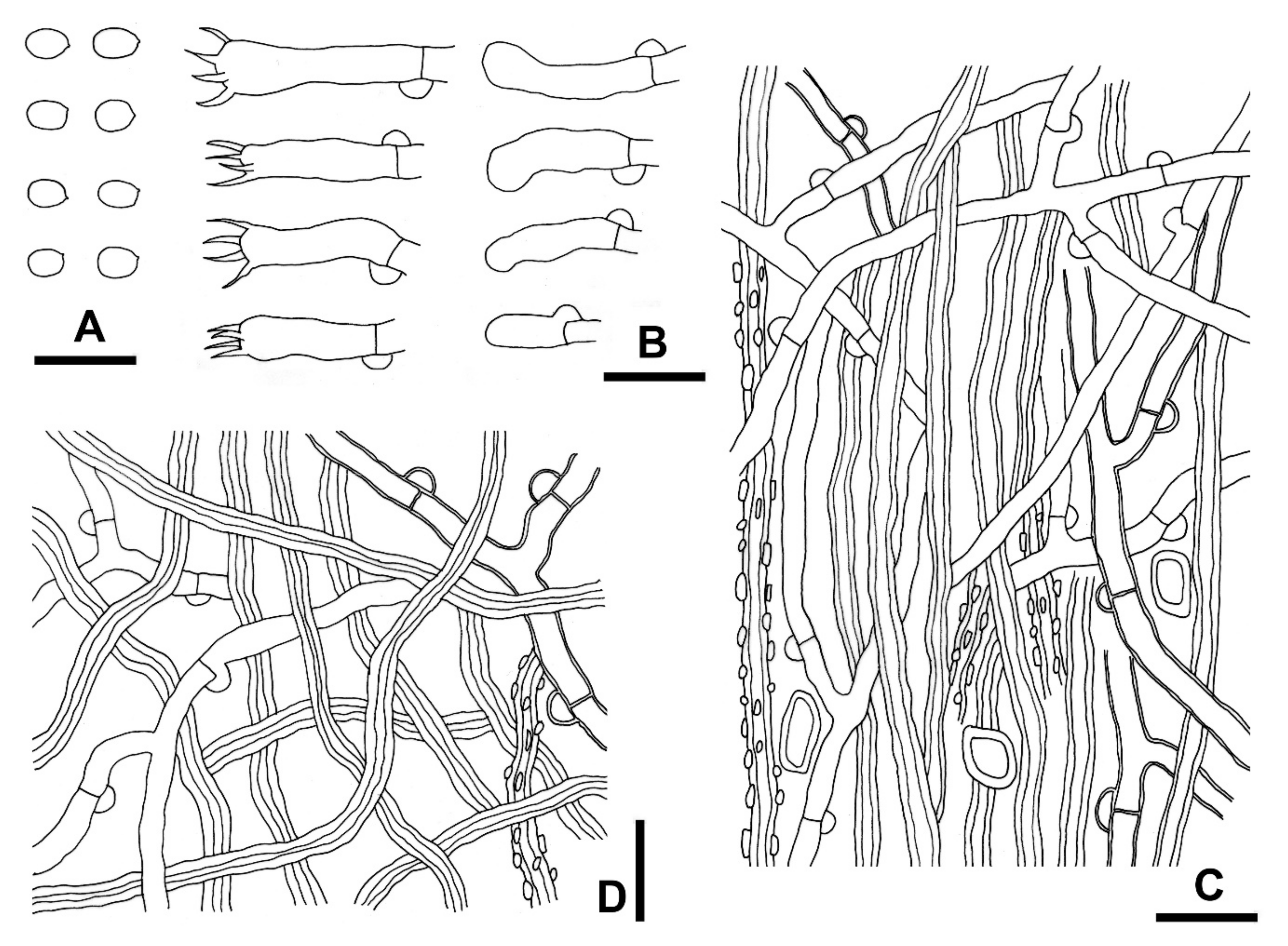Two New Species of Fibrodontia (Trechisporales, Basidiomycota) with a Key to Worldwide Species
Abstract
:1. Introduction
2. Materials and Methods
2.1. Morphological Examination
2.2. DNA Amplification and Sequencing
2.3. Phylogenetic Analyses
3. Results
4. Taxonomy
| A key to worldwide species of Fibrodontia | |
| 1a. Hymenophore odontioid to hydnoid, aculei up to 1.5 mm long | 2 |
| b. Hymenophore grandinioid to odontioid, aculei up to 0.7 mm long | 3 |
| 2a. Aculei usually less than 1 mm long, skeletal hyphae (2.5–)3.5–4.5 μm wide | F. gossypina |
| b. Aculei usually more than 1 mm long, skeletal hyphae 1.5–3.5 μm wide | F. subalba |
| 3a. Basidiospores generally 7–9 μm long | F. tomentosa |
| b. Basidiospores generally 3.5–5.5 μm long | 4 |
| 4a. Skeletal hyphae smooth | F. austrosinensis |
| b. Skeletal hyphae usually encrusted with crystals | 5 |
| 5a. Basidiospores generally broadly ellipsoid to globose, 4.5–5 × 3.5–4.5 μm | F. brevidens |
| b. Basidiospores generally ellipsoid to ovoid, 3.5–4.5 × 2.5–3 μm | F. alba |
5. Discussion
Author Contributions
Funding
Data Availability Statement
Acknowledgments
Conflicts of Interest
References
- Parmasto, E. Conspectus systematis Corticiacearum; Institutum Zoologicum et Botanicum Academiae Scientiarum R.P.S.S.: Tartu, Estonia, 1968; pp. 1–97. [Google Scholar]
- Eriksson, J.; Hjortstam, K.; Ryvarden, L. The Corticiaceae of North Europe: Phlebia—Sarcodontia; Grønlands Eskefabrikk: Oslo, Norway, 1981; Volume 6, pp. 1051–1276. [Google Scholar]
- Langer, E. Die Gattung Hyphodontia John Eriksson. Bibl. Mycol. 1994, 154, 1–298. [Google Scholar]
- Binder, M.; Hibbett, D.S.; Larsson, K.H.; Larsson, E.; Langer, E.; Langer, G. The phylogenetic distribution of resupinate forms across the major clades of mushroom-forming fungi (Homobasidiomycetes). Syst. Biodivers. 2005, 3, 113–157. [Google Scholar] [CrossRef]
- Larsson, K.H. Re-thinking the classification of corticioid fungi. Mycol. Res. 2007, 111, 1040–1063. [Google Scholar] [CrossRef]
- Wang, X.W.; May, T.W.; Liu, S.L.; Zhou, L.W. Towards a natural classification of Hyphodontia sensu lato and the trait evolution of basidiocarps within Hymenochaetales (Basidiomycota). J. Fungi 2021, 7, 478. [Google Scholar] [CrossRef]
- Hjortstam, K.; Ryvarden, L.; Iturriaga, T. Studies in corticioid fungi from Venezuela II (Basidiomycotina, Aphyllophorales). Synop. Fungorum 2005, 20, 42–78. [Google Scholar]
- Yurchenko, E.; Wu, S.H. Fibrodontia alba sp. nov. (Basidiomycota) from Taiwan. Mycoscience 2014, 55, 336–343. [Google Scholar] [CrossRef]
- Yurchenko, E.; Wu, S.H. New Asian records and morphological variation in Fibrodontia brevidens (Basidiomycota). Mycotaxon 2012, 122, 293–301. [Google Scholar] [CrossRef]
- Liu, S.L.; Ma, H.X.; He, S.H.; Dai, Y.C. Four new corticioid species in Trechisporales (Basidiomycota) from East Asia and notes on phylogeny of the order. MycoKeys 2019, 48, 97–113. [Google Scholar] [CrossRef]
- Kornerup, A.; Wanscher, J.H. Methuen Handbook of Colour, 3rd ed.; Eyre Methuen: London, UK, 1978; pp. 1–252. [Google Scholar]
- Wang, X.W.; Jiang, J.H.; Zhou, L.W. Basidioradulum mayi and B. tasmanicum spp. nov. (Hymenochaetales, Basidiomycota) from both sides of Bass Strait, Australia. Sci. Rep. 2020, 10, 102. [Google Scholar] [CrossRef]
- White, T.J.; Bruns, T.; Lee, S.; Taylor, J. Amplification and direct sequencing of fungal ribosomal RNA genes for phylogenetics. In PCR Protocols: A Guide to Methods and Applications; Innis, M.A., Gelfand, D.H., Sninsky, J.J., White, T.J., Eds.; Academic Press: San Diego, CA, USA, 1990; pp. 315–322. [Google Scholar]
- Vilgalys, R.; Hester, M. Rapid genetic identification and mapping of enzymatically amplified ribosomal DNA from several Cryptococcus species. J. Bacteriol. 1990, 172, 4238–4246. [Google Scholar] [CrossRef] [PubMed] [Green Version]
- Rehner, S.A.; Buckley, E. A Beauveria phylogeny inferred from nuclear ITS and EF1-α sequences: Evidence for cryptic diversification and links to Cordyceps teleomorphs. Mycologia 2005, 97, 84–98. [Google Scholar] [CrossRef]
- Liu, Y.L.; Whelen, S.; Hall, B.D. Phylogenetic relationships among ascomycetes: Evidence from an RNA polymerase II subunit. Mol. Biol. Evol. 1999, 16, 1799–1808. [Google Scholar] [CrossRef]
- Matheny, P.B. Improving phylogenetic inference of mushrooms with RPB1 and RPB2 nucleotide sequences (Inocybe, Agaricales). Mol. Phylogenet. Evol. 2005, 35, 1–20. [Google Scholar] [CrossRef] [PubMed]
- Katoh, K.; Standley, D.M. MAFFT multiple sequence alignment software version 7: Improvements in performance and usability. Mol. Biol. Evol. 2013, 30, 772–780. [Google Scholar] [CrossRef] [PubMed] [Green Version]
- Katoh, K.; Kuma, K.; Toh, H.; Miyata, T. MAFFT version 5: Improvement in accuracy of multiple sequence alignment. Nucleic Acids Res. 2005, 33, 511–518. [Google Scholar] [CrossRef] [PubMed]
- Guindon, S.; Gascuel, O. A simple, fast and accurate algorithm to estimate large phylogenies by maximum likelihood. Syst. Biol. 2003, 52, 696–704. [Google Scholar] [CrossRef] [Green Version]
- Darriba, D.; Taboada, G.L.; Doallo, R.; Posada, D. jModelTest 2: More models, new heuristics and parallel computing. Nat. Methods 2012, 9, 772. [Google Scholar] [CrossRef] [Green Version]
- Ronquist, F.; Teslenko, M.; van der Mark, P.; Ayres, D.L.; Darling, A.; Höhna, S.; Larget, B.; Liu, L.; Suchard, M.A.; Huelsenbeck, J.P. MrBayes 3.2: Efficient Bayesian phylogenetic inference and model choice across a large model space. Syst. Biol. 2012, 61, 539–542. [Google Scholar] [CrossRef] [Green Version]
- Rambaut, A.; Drummond, A.J.; Xie, D.; Baele, G.; Suchard, M.A. Posterior summarisation in Bayesian phylogenetics using Tracer 1.7. Syst. Biol. 2018, 67, 901–904. [Google Scholar] [CrossRef] [PubMed] [Green Version]
- Stamatakis, A. RAxML-VI-HPC: Maximum likelihood-based phylogenetic analyses with thousands of taxa and mixed models. Bioinformatics 2006, 22, 2688–2690. [Google Scholar] [CrossRef]
- Edler, D.; Klein, J.; Antonelli, A.; Silvestro, D. RaxmlGUI 2.0: A graphical interface and toolkit for phylogenetic analyses using RAxML. Methods Ecol. Evol. 2021, 12, 373–377. [Google Scholar] [CrossRef]
- Pattengale, N.D.; Alipour, M.; Bininda-Emonds, O.R.P.; Moret, B.M.E.; Stamatakis, A. How many bootstrap replicates are necessary? J. Comput. Biol. 2010, 17, 337–354. [Google Scholar] [CrossRef]
- Zhang, J.; Kapli, P.; Pavlidis, P.; Stamatakis, A. A general species delimitation method with applications to phylogenetic placements. Bioinformatics 2013, 29, 2869–2876. [Google Scholar] [CrossRef] [PubMed] [Green Version]
- Puillandre, N.; Lambert, A.; Brouillet, S.; Achaz, G. ABGD, Automatic Barcode Gap Discovery for primary species delimitation. Mol. Ecol. 2012, 21, 1864–1877. [Google Scholar] [CrossRef] [PubMed]
- Kumar, S.; Stecher, G.; Li, M.; Knyaz, C.; Tamura, K. MEGA X: Molecular evolutionary genetics analysis across computing platforms. Mol. Biol. Evol. 2018, 35, 1547–1549. [Google Scholar] [CrossRef] [PubMed]
- Ryvarden, L. Studies in the Aphyllophorales of Africa 6. Some species from eastern Central Africa. Bull. Jard. Bot. Natl. Belg. 1978, 48, 79–119. [Google Scholar] [CrossRef]
- Berkeley, M.J.; Curtis, M.A. Fungi Cubenses (Hymenomycetes). J. Linn. Soc. Bot. 1869, 10, 280–392. [Google Scholar] [CrossRef]
- Baltazar, J.M.; Silveira, R.M.B.; Rajchenberg, M. Type studies of J. Rick’s corticioid homobasidiomycetes (Agaricomycetes, Basidiomycota) housed in the Herbarium Anchieta (PACA). Phytotaxa 2016, 255, 101–132. [Google Scholar] [CrossRef]
- Rick, J. Recensentur fungi resupinati rari et novi Americae meridionalis. Lilloa 1943, 9, 215–219. [Google Scholar]






| Species | Voucher Number | GenBank Accession Number | |||
|---|---|---|---|---|---|
| ITS | 28S | tef1α | rpb2 | ||
| Brevicellicium exile | MA:Fungi:76132 | HE963779 | — | — | — |
| Fibrodontia alba | TNM F24944 | NR153983 | NG060401 | — | — |
| EYu 110703-25 | KC928274 | KC928275 | — | — | |
| EYu 110417-10 | JQ612713 | JQ612714 | — | — | |
| He 4761 | MK204529 | MK204541 | MW478697 | MW478705 | |
| LWZ 20170820-34 | MT802108 | MT802102 | MW478698 | MW478706 | |
| LWZ 20180923-4 | MT802107 | MT802101 | MW478696 | MW478704 | |
| CLZhao 3488 | MK268910 | — | — | — | |
| Fibrodontia austrosinensis | LWZ 20190820-11b | MT802111 | MT802105 | MW478700 | MW478709 |
| He 3453 | MT802109 | MT802103 | — | MW478708 | |
| He 6283 | MT802110 | MT802104 | MW478699 | MW478710 | |
| Fibrodontia brevidens | Wu 9807-16 | KC928276 | KC928277 | — | — |
| He 3559 | MK204528 | — | MW478701 | MW478707 | |
| CLZhao 3417 | MK268911 | — | — | — | |
| Fibrodontia gossypina | AFTOL-ID 599 | DQ249274 | AY646100 | — | — |
| GEL 5042 | — | AJ406421 | — | — | |
| Fibrodontia subalba | Dai 15931 | MT802106 | MT802100 | — | — |
| Hyphodontia subalutacea | GEL 2196 | DQ340341 | DQ340362 | — | — |
| Hyphodontia floccosa | Berglund 150-02 | DQ873618 | DQ873618 | — | — |
| Porpomyces submucidus | Dai 13708 | KT152144 | KT152146 | MW478702 | — |
| Sistotremastrum suecicum | KHL 11849 | EU118666 | EU118667 | — | — |
| Sistotremastrum sp. | LWZ 20191107-25 | MW474864 | MW477771 | MW478703 | MW478712 |
| Subulicystidium longisporum | KHL 14229 | MH000601 | MH000601 | — | — |
| Subulicystidium tropicum | He 3968 | MK204531 | MK204544 | — | MW478711 |
| Trechispora echinospora | E 11/37-12 | JX392853 | JX392854 | — | — |
| Tubulicium vermiferum | KHL 8714 | — | AY463477 | — | — |
| Species | 1 | 2 | 3 | 4 | 5 | |
|---|---|---|---|---|---|---|
| 1 | F. alba | 0.0117 | ||||
| 2 | F. subalba | 0.0554 | n.a. | |||
| 3 | F. brevidens | 0.0719 | 0.0758 | 0.0006 | ||
| 4 | F. austrosinensis | 0.0554 | 0.0592 | 0.0530 | 0.0012 | |
| 5 | F. gossypina | 0.0879 | 0.0903 | 0.1045 | 0.0781 | n.a. |
Publisher’s Note: MDPI stays neutral with regard to jurisdictional claims in published maps and institutional affiliations. |
© 2021 by the authors. Licensee MDPI, Basel, Switzerland. This article is an open access article distributed under the terms and conditions of the Creative Commons Attribution (CC BY) license (https://creativecommons.org/licenses/by/4.0/).
Share and Cite
Liu, S.-L.; He, S.-H.; Liu, D.-M.; Zhou, L.-W. Two New Species of Fibrodontia (Trechisporales, Basidiomycota) with a Key to Worldwide Species. J. Fungi 2021, 7, 982. https://doi.org/10.3390/jof7110982
Liu S-L, He S-H, Liu D-M, Zhou L-W. Two New Species of Fibrodontia (Trechisporales, Basidiomycota) with a Key to Worldwide Species. Journal of Fungi. 2021; 7(11):982. https://doi.org/10.3390/jof7110982
Chicago/Turabian StyleLiu, Shi-Liang, Shuang-Hui He, Dong-Mei Liu, and Li-Wei Zhou. 2021. "Two New Species of Fibrodontia (Trechisporales, Basidiomycota) with a Key to Worldwide Species" Journal of Fungi 7, no. 11: 982. https://doi.org/10.3390/jof7110982
APA StyleLiu, S.-L., He, S.-H., Liu, D.-M., & Zhou, L.-W. (2021). Two New Species of Fibrodontia (Trechisporales, Basidiomycota) with a Key to Worldwide Species. Journal of Fungi, 7(11), 982. https://doi.org/10.3390/jof7110982






